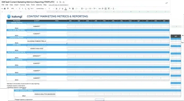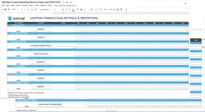Key metrics for B2B SaaS marketing and sales leaders
There are plenty of metrics for SaaS sales and marketing leaders to keep tabs on, but there's one dashboard every B2B software marketing leader...

Regardless of industry, content marketing can be difficult to commit to, master and scale.
In order to build a scalable demand generation engine and drive brand awareness, content marketing is no longer an option. After all, B2B Account-Based Marketing (ABM) and lead nurturing are dependent on great content.
You can’t determine how your content is performing without measuring success. In order to measure the success and impact of your SaaS content marketing, you need to define your goals and establish metrics. Here’s everything you need to know, including what metrics to measure.

Download our content marketing metrics template to set up your own personalized dashboard and start measuring success.
Content marketing becomes easier if you know what you want to achieve.
Measuring the outcomes of your content marketing is critical for modern PR, audience and target marketing. It allows you to fine-tune your content planning, production, dissemination, amplification and optimization.
One of the most important elements of SaaS content marketing is to help potential customers understand your offering. That being said, there are three common goals in SaaS content marketing: brand awareness, demand generation and audience engagement.
Content marketing is the best way for most brands to establish authority in the industry, connect with audiences, boost revenue and increase brand awareness.
There are certain metrics you should be measuring to see if your content is not only relevant and valuable but also aligned with your content marketing strategy and meet your goals. Here are 5 metrics to measure.
A key part of your content marketing strategy is SEO, and this is where organic traffic comes in. Organic traffic is the traffic you earn from appearing in the search engine results pages (SERPs) without paying for placement.
It’s important to track your overall organic traffic so that you can see how many people are visiting your site as a result of your content strategy. Measuring organic traffic to your blog and landing pages will allow you to gauge the performance of your content so you can see where you might need improvement.
Where to measure: Hubspot or Google Analytics
Your total blog views will provide insight on how your blog content is performing and how important your blog is for your audience. This will be relative to your own industry and company. If you don’t know how to establish a baseline or benchmark for the future of your tracking, start out with the past 6 months of total views & adjust as needed.
Where to measure: Hubspot or Google Analytics
While this content marketing metric may seem unnecessary, it is important, as you can’t truly gauge the results of your metrics without also considering whether or not you have posted any new content.
Measuring content published allows you to see whether or not you are in line with your content strategy. This gives you an opportunity to adapt or make any changes if you need to and allows you to identify any blockers for content.
Where to measure: Hubspot or Google Analytics. You can also reference your content calendar or project management system if you keep them up to date.
Tracking your top posts will show you how your content is performing and measuring up against each other. It also gives you a better idea of what is resonating with your audience and what type of content they are most interested in.
Where to measure: Google Analytics
The number of keywords in the top 10 is another great way to show you how your content is performing in search engines. SEMrush or other SEO-tracking tools provide options for daily or weekly reports, insight into competitor movement, and show trends over time.
This data is also closely linked to and reflected in your organic traffic -- the more keywords you’re ranking for, the more likely your traffic and organic blog views will grow.
Where to measure: SEMRush or other keyword research tools
These five content marketing metrics will allow you to measure the success of your content so you can make the right decisions for your SaaS business. You might be wondering, ‘but what about bounce rate? Average time on-page? Referral traffic?
While those metrics can help measure your content, they aren’t the best metrics to focus on. For example, bounce rates are poor indicators for performance, because if someone performs an initial action, like a site visit, but doesn’t interact a second time (by viewing another page, clicking a CTA, etc.) within 30 minutes, it’s considered a bounce, even though they could have engaged and gotten what they needed to. Likewise, the average time on page for your blog varies as you post more content at different lengths and for different reasons, not providing you with a concrete number you should measure against.
In addition to the 5 metrics already mentioned, there are a few more content marketing metrics that are worth measuring.
I’ve noted some of the key content marketing metrics I use to measure the impact of my content marketing, but there are also some “nice-to-have” metrics I like to look at to see the big-picture and analyze the true impact of content.
There are some additional metrics you can look at so you know where and how to improve your content.
Measuring your content isn’t a one-time effort. Like any process, having the right monitoring and tools in place is crucial for identifying key opportunities, making meaningful changes and reporting results to your boss and/or stakeholders.
Sometimes the content that you think is the best quality just doesn’t resonate with your audience. These metrics will help to not only help you identify poor-performing content that can be improved, but it will also allow you to find your best-performing content. Data analytics can help you to find the perfect recipe for your content so you can reach your content marketing goals.
(Note: Some of your metrics may not change from week to week or month to month, use what works best for you)

Access our Kalungi content metrics template to help you measure the impact of your content marketing and set up your own personalized dashboard. Use it for your own content and evaluate where you can improve content marketing outcomes.
Fadi co-founded Kalungi in 2018 with Stijn Hendrikse. He has over 20 years of experience in marketing and building businesses. He is a certified HubSpot Champion User.
There are plenty of metrics for SaaS sales and marketing leaders to keep tabs on, but there's one dashboard every B2B software marketing leader...
Before you invest in fancy dashboard solutions and marketing metric platforms, make sure to reap the benefits from what Google provides for free.
rack the right B2B SaaS metrics for growth. Learn key KPIs and download our FREE SaaS Metrics Dashboard Template to optimize your performance!
Be the first to know about new B2B SaaS Marketing insights to build or refine your marketing function with the tools and knowledge of today’s industry.